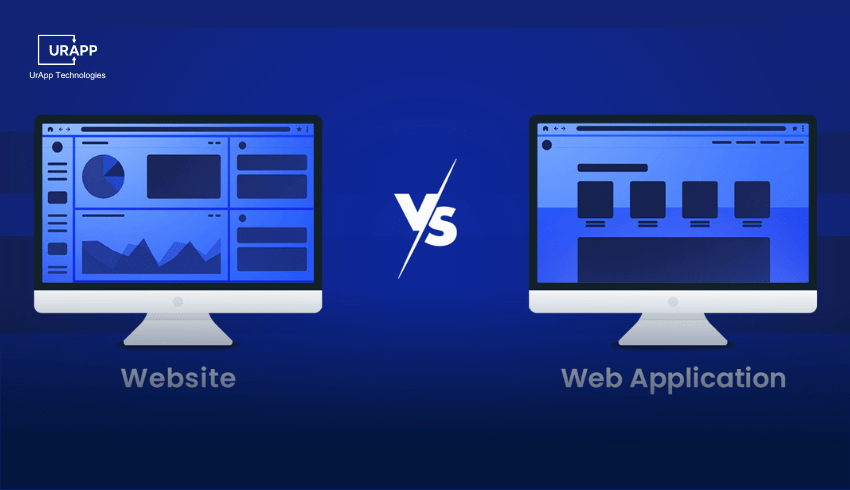Web Applications vs Websites: Key Differences, Features & Use Cases
Confused between a website and a web application? Learn how each works, their unique features, real-world examples, and which solution best fits your business needs.
What is Websites and Web Applications?
Website
- A website combines multiple web pages into a single platform to share information. It provides basic interaction for users and is commonly used to display company details, blogs, news, and portfolios.
Web Application
- A web application is an interactive system that allows users to perform tasks and processes data dynamically. Examples include online banking systems, social media platforms, and e-commerce stores.
Key Differences Between Websites and Web Applications
| Aspect | Website | Web Application |
|---|---|---|
| Goals and Capabilities | Designed to inform and promote products or services. Primarily used to showcase company information, blogs, or portfolios. |
Built for user interaction and task completion. Allows users to engage with data, submit forms, or manage content. |
| Purpose and Functionality | Focused on delivering content and promoting offerings. Limited to displaying static or dynamic content without deep interaction. |
Enables users to perform actions like logging in, purchasing, or uploading files. Offers functionality beyond just presenting information. |
| User Interaction | Minimal interaction; mostly read-only experience. Users can browse, click links, and view content. |
High interactivity; users can input, modify, or retrieve data. Examples include dashboards, forms, and real-time features. |
| Development Complexity | Simpler to develop using basic HTML, CSS, and JavaScript. Faster turnaround time with lower development cost. |
Requires complex development with frameworks, backend logic, and databases. Longer timelines and advanced technical skills needed. |
| Maintenance | Easier to maintain with periodic content updates. Typically doesn’t need frequent backend changes. |
Requires ongoing maintenance due to changing features and user needs. Continuous testing and updates are essential. |
| Security Considerations | Basic security measures like SSL certificates and secure hosting. Suitable for general informational content. |
Needs strong security like user authentication, data encryption, and role-based access. Regular audits and security updates are critical. |
| Greater Accessibility Across Platforms | Accessible via browsers on most devices but may lack the flexibility of a full app experience. Limited offline access and functionality when compared to more dynamic platforms. |
Built using modern technologies that ensure seamless access across desktops, tablets, and smartphones. Easier to develop today thanks to cross-platform tools and experienced development teams. |
Key Features of Websites:

Navigation
- Makes it easy for visitors to find what they’re looking for without getting lost.
- A clean, simple menu can make a huge difference in how long someone stays on your site.
Responsiveness
- Your site should look good and work well on phones, tablets, and desktops.
- If it’s not mobile-friendly, people will probably bounce fast.
Content
- Good content keeps people interested and answers their questions.
- It should be useful, clear, and ideally help with your search rankings too.
Design
- First impressions matter — a modern, clean design helps build trust.
- Consistent colors, fonts, and spacing make everything feel more professional.
Security
- People need to feel safe, especially if they’re entering info or making payments.
- SSL and basic protections like HTTPS are a must these days.
Calls to Action (CTAs)
- Every page should guide people toward what to do next — like signing up or buying.
- Clear, simple CTAs help turn visitors into customers or leads.
Key Features of Web Apps
User-Friendly Interface
- Simple, clean layouts help users find what they need without confusion.
- Clear navigation and organized content make the experience smooth and intuitive.
Fast Load Times
- Nobody likes waiting — quick loading keeps users engaged from the start.
- Speed improves user satisfaction and helps with better search engine rankings.
Mobile & Tablet Ready
- The app should look and work great on phones, tablets, and desktops.
- A mobile-friendly experience increases reach and accessibility for all users.
Strong Security
- Protects sensitive data through encryption and secure logins.
- Builds trust by keeping user information safe from threats and breaches.
Real-Time Updates
- Content can refresh instantly based on user actions or new data.
- Keeps everything fresh without needing users to reload or restart the app.
Easy Integrations
- Connects smoothly with tools like payment systems, CRMs, and social platforms.
- Adds more power and convenience by working alongside your existing systems.
User Authentication
- Allows users to sign up and log in for a personalized experience.
- Supports features like profiles, saved data, and secure sessions.
Scalable Performance
- Handles more users and traffic as your business grows.
- No slowdowns — just reliable performance no matter how big things.
Use Cases: Websites vs Web Applications
Websites:
E-Commerce Storefront:
Showcase products, provide descriptions, and allow basic online purchases.
Example: A small online shop selling handmade crafts with a simple website.
Company Portfolio:
Display company information, services, and news updates.
Example: A digital agency website presenting their team, projects, and blog.
Blogs & News Sites:
Share articles, updates, and industry insights.
Example: A tech blog posting daily articles and tutorials.
Web Applications:
Online Learning Platforms:
Enable course enrollment, track progress, and allow real-time interaction.
Example: Coursera or Udemy.
Social Media Networks:
Let users create profiles, connect, and share content dynamically.
Example: Facebook or LinkedIn.
E-Commerce Management Systems:
Let customers track orders, manage accounts, and personalize shopping experiences.
Example: Shopify store dashboards or Amazon customer accounts.
Online Banking:
Facilitate transactions, balance checking, and secure financial operations.
Example: Chase Online Banking or PayPal.
Development Process of Websites and Web Apps:

Website and web app development processes are very different, but if you understand these procedures it will help you in picking out the best course of action for your project and assess what is a web app vs website based on complexity and scale.
Website Development Process
Planning
-
Define goals and objectives.
-
Identify target audience.
-
Choose a domain name.
Design
-
Create wireframes and mockups.
-
Select color schemes and fonts.
-
Develop a user-friendly layout.
Development
-
Code the website using HTML, CSS and JavaScript.
-
Integrate necessary features like contact forms and e-commerce capabilities.
Testing
-
Conduct usability testing to ensure a smooth user experience.
-
Check for bugs and issues across different devices and browsers.
Launch
-
Deploy the website to a live server.
-
Promote the website through digital marketing strategies.
Maintenance
-
Regularly update content and features.
-
Monitor performance and user feedback.
Web App Development Process

Planning
-
Define core functionalities and features.
-
Create a project timeline.
Design
-
Design user interfaces with a focus on user experience.
-
Develop prototypes for testing.
Development
-
Use programming languages like JavaScript, Python, or Ruby.
-
Implement database management systems for data storage.
Quality Assurance
-
Perform rigorous testing to identify bugs and issues.
-
Ensure compatibility across various devices and platforms.
Start
-
Deploy the web app on a cloud server or hosting platform.
-
Promote the app to attract users.
Maintenance
-
Continuously update and improve features based on user feedback.
-
Monitor performance and security.
Technologies Used in Website and Web App Development
Different technologies support website and web app development. The selection often depends on the business model and the goals behind choosing web application vs website.

Technologies for Websites
HTML/CSS
- The foundation for building web pages. HTML structures the content, while CSS styles it.
JavaScript
- Adds interactivity and dynamic content to websites.
Content Management Systems (CMS)
- Tools like WordPress and Joomla simplify website creation.
Technologies for Web Apps
Frameworks
- Angular, React and Vue.js help build interactive UIs.
Backend Technologies
- Node.js, Python and Ruby support server-side operations.
Databases
- MySQL and MongoDB store and manage data
Conclusion
For each business owner, it is important to understand the difference between web apps vs websites. Websites are generally available, economical and content-driven. Web apps provide longer-term scalability, improved engagement and richer functionality.
If you want to add your own digital product, partner with the best web development company today. Our expertise in mobile app development, web development and digital transformation can help you achieve your goals. So if you want to start your product today, give us a call .







